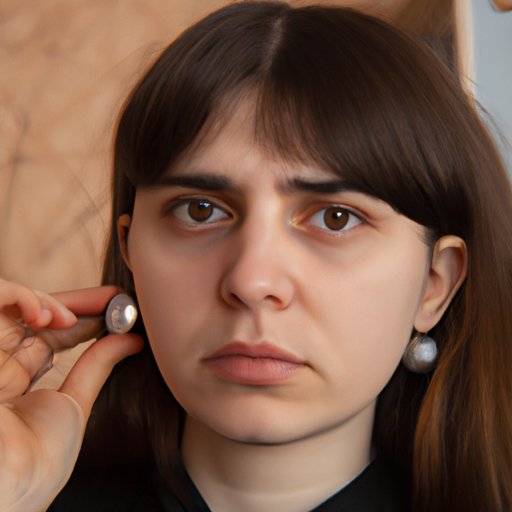I. Introduction
Have you noticed an unsightly bump near your piercing? You’re not alone. Piercing bumps are a common complaint among body piercers and can occur anywhere on the body that’s been pierced, such as the ear, nose, or belly button. This article aims to provide you with a comprehensive guide on how to get rid of piercing bumps effectively.
II. How to Prevent Piercing Bumps in the First Place
Prevention is always better than cure, and this is particularly true when it comes to piercing bumps. Here are some tips for preventing them from forming in the first place:
Proper Piercing Technique
First and foremost, it’s essential to ensure that the piercing is carried out by a professional using the correct techniques. Using an experienced piercer who follows proper piercing protocol greatly reduces the risk of developing piercing bumps.
Choosing the Right Jewelry
Selecting the correct jewelry for your piercing is just as important as choosing the right piercer. Ensure that the jewelry is made from high-quality materials and appropriate for your piercing. It would be best if you also chose the correct size of jewelry, which is not too tight or too loose, as this can irritate the skin.
Avoid Touching or Playing with the Piercing
Keep your hands off! Touching or playing with the piercing can lead to piercing bumps and other complications such as infection. It’s also essential to avoid over-cleaning or under-cleaning the piercing.
III. Home Remedies for Treating Piercing Bumps
If you already have a piercing bump, there are several home remedies you can try before seeking medical treatment. Here are some of the most effective:
Sea Salt Soaks
Sea salt soaks are the most popular home remedy for treating piercing bumps. Mix a quarter teaspoon of sea salt with one cup of boiling water and allow it to cool. Once cooled, soak a clean piece of cotton wool or gauze in the solution and press gently onto the bump for 10-15 minutes, at least twice a day, until the bump reduces.
Tea Tree Oil and Lavender Oil
Tea tree oil has antifungal and antibacterial properties and can help to reduce inflammation. Mix a few drops of tea tree oil and lavender oil together, and gently apply it to the piercing bump using a cotton swab. Do this twice daily.
Chamomile Compresses
Chamomile has anti-inflammatory properties and can help to soothe the skin. Brew a cup of chamomile tea and soak a clean piece of cotton wool or gauze in the tea. Gently press the compress onto the piercing bump for 10-15 minutes, at least twice a day.
IV. The Importance of Proper Aftercare for Preventing Piercing Bumps
Proper aftercare of a piercing is essential in preventing piercing bumps. Here are some of the most important aftercare steps to follow:
Follow Cleaning Instructions Carefully
Ensure that you follow the instructions of your piercer on how to clean the piercing. It generally involves cleaning the piercing twice a day with a saltwater solution or a mild liquid soap diluted in water. Avoid using hydrogen peroxide or alcohol solutions as these can dry out the skin.
Properly Dry the Piercing
After cleaning, dry your piercing with a clean piece of cotton wool or gauze. Avoid using towels as they can harbor bacteria that may lead to infection.
Avoid Activities That May Bump the Piercing
Avoid sports or other activities where the piercing may get knocked or exposed to sweat, dirt, or bacteria. Also, avoid swimming in pools, hot tubs, or other bodies of water, unless the piercing has fully healed.
V. How to Tell if Your Piercing Bump is Infected and What to Do About it
A piercing bump may become infected if proper aftercare is not followed. Here are some of the symptoms to look out for:
- Excessive swelling
- Increased pain
- Bleeding
- Pus discharge from the bump or piercing
- High fever
If you think your piercing bump is infected, it’s essential to seek medical attention immediately. An infected bump can lead to serious complications such as abscesses and even sepsis in extreme cases.
VI. Over-the-Counter Treatments for Piercing Bumps
If home remedies do not work, you can try over-the-counter treatments such as:
Hydrocortisone Cream
A hydrocortisone cream can help to reduce inflammation and irritation around the bump. Apply the cream as directed on the packaging.
Wound Cleansers
Antimicrobial wound cleansers can also help to reduce the size of the bump and prevent infection. Ensure that the cleanser is safe to use on a piercing and always follow the instructions.
VII. When to Seek Medical Attention for a Piercing Bump
If the bump persists or gets worse despite trying home remedies or over-the-counter treatments, it’s recommended to consult a professional piercer or doctor. Here are some of the reasons to seek medical attention:
- The bump becomes red or hot to the touch
- The bump releases pus or blood
- The bump is larger than a pea
- You have a high fever
- You experience severe pain
Seeking medical attention early can help prevent complications and ensure that the bump is treated appropriately.
VIII. Conclusion
Piercing bumps are common but can be easily treated at home or with medical intervention if necessary. Proper aftercare and prevention measures can help to avoid the development of piercing bumps. If you do develop a bump, don’t panic. Try some of the home remedies listed here, and if it persists, consult a professional piercer or doctor. Remember, with proper care and attention, a piercing bump can often be treated effectively.
